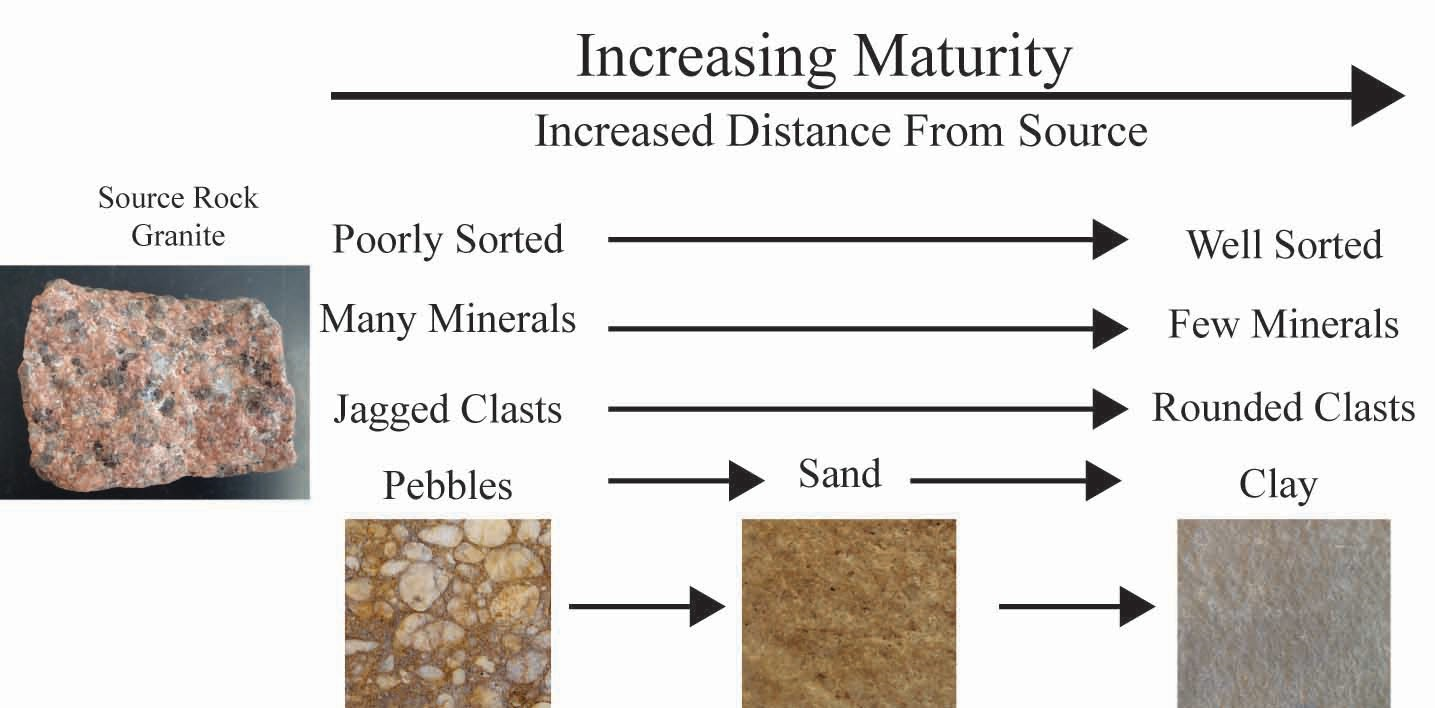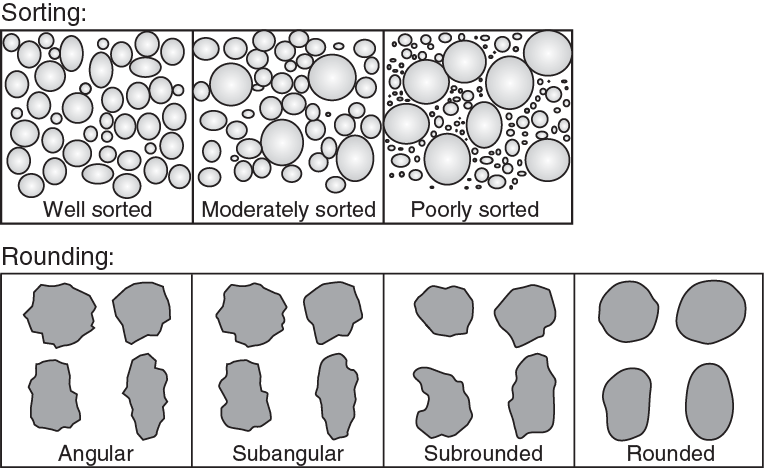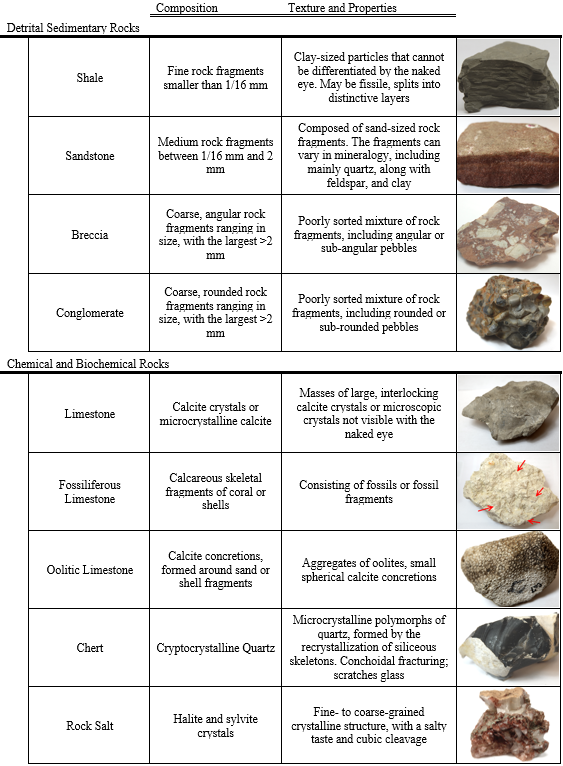Chapter 4. Sedimentary Rocks
Overview of Sedimentary Rocks
Weathering and Erosion
Sedimentary rocks are formed by the weathering, erosion, deposition, and lithification of sediments. Sedimentary rocks can be composed of pieces of other rocks, which are broken down by the process of weathering.
Weathering occurs in two different ways: First, rocks can be physically broken into smaller pieces (e.g. two rocks bump into each other, and one breaks), which is called mechanical weathering. Alternatively, rocks can be decomposed and altered at the atomic level (e.g. dissolving salt in water), which is called chemical weathering. There are multiple ways each type of weathering can occur, and both the rate that rocks break down and how they break down varies dramatically depending on the area and environment.
The most prevalent type of mechanical weathering is the collision, breaking, and grinding of rock by the movement of rocks within a fluid, either water or air. The size of sediment that can be carried depends on the type of fluid and how fast it moves. For example, a rapidly flowing river can carry large particles and cause immense amounts of weathering, while a calm stream would hardly cause any weathering. The density of the fluid also controls the size of particle that can be transported; a denser fluid, like water, can carry larger particles than a less dense fluid, like air.
Another common method of mechanical weathering is called frost wedging, which occurs when water seeps into cracks in the rock and freezes. Water expands when frozen, which pushes the crack wider, eventually splitting off pieces of rock.
The addition and subtraction of heat or pressure can also cause rock to break. Rocks can shatter when cooled very quickly, and can split off in layers when immense pressure is released.
Finally, plants, animals, and humans can cause significant amounts of weathering. Weathered sediments then undergo erosion, meaning the sediments are transported away where the weathering happened. Eventually they will be deposited, and turned into a rock.
Rocks can also be chemically weathered, most commonly by one of three processes. The process of dissolution is when water breaks a mineral or rock into ions (atoms or molecules with an electric charge). Ions can then be transported with the water and redeposited if the concentration of ions increases. Evaporation is a common way that the ion concentration is increased.
Chemical weathering can also change the mineral content of a rock and weaken the original material. Minerals can undergo hydrolysis, where a hydrogen atom from a water molecule replaces the cation in a mineral; this will alters minerals like feldspar into a softer clay mineral. Additionally, a mineral can undergo oxidation, where oxygen atoms alter the valence state of a cation; this normally occurs on a metal and is commonly known as rusting.
Chemical and mechanical weathering can work together to increase the overall rate of weathering. Chemical weathering weakens rocks, making them more prone to breaking physically, while mechanical weathering increases the surface area of the sediment, exposing more of it to chemical weathering Therefore, erosion can happen very quickly in environments with multiple types of weathering.
Identifying Sedimentary Rocks
Classification of sedimentary rocks is largely based on differentiating the processes that lead to their formation. The biggest division in sedimentary rock types is based on the primary type of weathering that leads to the material building the sedimentary rock. If the rock is largely made from pieces of rock (called clasts) that have been mechanically weathered, the rocks are referred to as clastic sedimentary rocks (or sometimes detrital sedimentary rocks). These rocks are composed of broken pieces of other rocks. For clastic sedimentary rocks, the specific minerals making up the clasts less important for naming the rocks than the physical properties of the sediment itself, such as the shape and size of the clasts.
Alternatively, if the rock is largely the product of chemical weathering, the classification is based on the composition of the material and the processes involved in the materials precipitation from solution. Chemical sedimentary rocks form from the inorganic precipitation of minerals from a fluid. Crystals begin to form when the ions present within a fluid, such as water, become very concentrated, either by the addition of more ions or the removal of water by freezing or evaporation. These kinds of sedimentary rocks are named based on the minerals they contain.
If organisms facilitate the precipitation of these minerals from water we refer to the rocks as biochemical sedimentary rocks. An example of biochemical precipitation is the formation of skeletal minerals in many organisms: from starfish and clams that grow calcite, to sponges that grow silica-based material, to humans that have bones made of hydroxyapatite.
Clastic Sedimentary Rocks
Weathering and erosion move sediments from areas that are at high elevation, such as mountains, and deposit sediments in lower areas such as valleys, lakes, or the ocean. As the sediment moves, whether carried by ice, water, or in the air, it changes in ways that give us clues about what has happened to it. We can tell how much the sediment has changed, how far it has travelled, and what mechanism moved it by looking at the texture and composition of clasts making up a sedimentary rock. The extent to which the grains within a sedimentary rock have been altered by their transport is described in terms of maturity. The farther grains have been transported and acted upon by physical and chemical weathering before being deposited and turned into rock, the more mature those grains will be.
To understand maturity, imagine a mountain composed of granite, and think about how the sediment from this mountain changes as it makes the long journey by river to the ocean (Figure 4.1). First, the rock is mechanically broken down into smaller pieces, which creates sediment that has jagged clasts in a variety of sizes (the sizes of clasts in these rocks can range from large boulders, to cobbles, to pebbles, to the smallest particles, clay), and including all of the minerals from the original granite.

As this sediment is transported in the river, the clasts collide with each other. They break into smaller pieces, and the sharp edges are knocked off. The extent to which the sharp edges have been knocked off clasts is referred to as rounding (Figure 4.2, bottom). As the slope of the land decreases, the river slows. It leaves behind the large boulders and cobbles, while carrying away the smaller particles. As the sediments get farther from their source, they become more uniform in size. This is a process called sorting (Figure 4.2, top). As the particles are carried along, chemical weathering also occurs, altering the feldspars into tiny particles of clay.

In summary, the granite is reduced from boulders and cobbles close to the mountain, to pebbles in the rivers, to pure and uniform quartz sand at the beach, and minuscule clay grains on the ocean floor. Different clastic rocks will form from sediments that were deposited at various stages of this journey.
In this lab you will look at four main types of clastic rocks: conglomerate, breccia, sandstone, and shale. Conglomerate is an immature sedimentary rock (i.e. it has been transported a relatively short distance) that is a poorly sorted mixture of clay, sand, and rounded pebbles. The mineralogy of the clasts will vary depending on their source. Conglomerates can be found in deposits such as ancient landslides or pebble beds in rivers.
Breccia is an immature sedimentary rock that is a poorly sorted mixture of clay, sand, and pebbles, but the clasts are angular (they have sharp corners and edges) instead of being rounded off as with conglomerate. The mineralogy of the clasts can vary depending on their source. Breccia can be found next to fault zones and debris flows.
Sandstone consists of sand-sized clasts. These clasts can vary from jagged to rounded, and can contain many minerals or just quartz. Sandstone can range in maturity. Sandstone formed from mountain river deposits (and thus relatively close to their source) are immature. Immature sandstones that still retain a significant amount of feldspar are called arkose sandstones. In contrast, sandstone formed from sediments deposited on beaches very far away from the source will be mature, consisting almost entirely of pure white quartz. These are called quartz sandstones.
Shale has the smallest clay-sized clasts, and a finely layered appearance. It is fissile, meaning it breaks into thin sheets. Shale is made from particles tiny enough to be carried by wind or barely moving water, and thus can be found thousands of kilometers away from the original source. Siltstone is made of silt-sized particles (slightly larger than clay). The particles for shale and siltstone are so small that you won’t be able to see a difference with the unaided eye, but you can still tell shale and siltstone apart. Unlike shale, siltstone does not have fine layering and is not fissile.
The characteristics of these clastic sedimentary rocks are summarized in the top part of Table 4.1.
Biochemical and Chemical Sedimentary Rocks
Biochemical and chemical sedimentary rocks precipitate either directly from water or through the activity of organisms. The most recognizable chemical sedimentary rocks are evaporites, which are minerals that are formed by the precipitation of minerals from the evaporation of water. You have already examined multiple examples of evaporites in a previous lab, such as halite and gypsum (selenite). In this lab, we will focus on siliceous and carbonate biochemical sedimentary rocks.
Chert is a rock composed of microcrystalline varieties of quartz, and thus it has properties that are associated with quartz itself, such as conchoidal fracturing and hardness greater than glass. Chert is often formed deep in the ocean from silicious material that is either inorganic (e.g. silica clay) or biologic (e.g. skeletons of sponges and single-celled organisms) in origin.
Carbonate rocks are made up of carbonate minerals (i.e., minerals with the CO3-2 anion). A very common carbonate rock is limestone, composed of the carbonate mineral calcite (CaCO3). Limestone weathers relatively easily, leading to karst landscapes with networks of large caves. Sinkholes can form when rocks collapse into cavities formed by dissolution of limestone. Because limestone contains CaCO3, it will fizz when acid is added.
Limestone that consists entirely of crystals of calcite or microcrystalline masses of calcite is called crystalline limestone, but limestone can vary greatly in its appearance, depending on how it is formed. As with chert, limestone can form inorganically from a highly concentrated solution of calcium and carbonate ions in water in varying environments, from caves to tropical beaches. Sometimes the back-and-forth motion of waves on tropical beaches can result in the formation of tiny calcite spheres called ooids (rhymes with “druids”). The ooids can collect into a solid mass called oolitic limestone.
Alternatively, limestone can be formed biologically with the most striking example being fossiliferous limestone, which contains fragments of carbonate fossils such as shells or coral.
The characteristics of chemical and biochemical sedimentary rocks are summarized in the bottom part of Table 4.1.

Sedimentary Rocks That Are Difficult to Classify
Sedimentary rocks that are formed from accumulations of weathered and transported particles are clastic sedimentary rocks, but not all rocks that form from an accumulation of sediment fit neatly into the classification system for clastic rocks. For example, if the sediments making up the rock are almost entirely of carbonate shells, then is the rock clastic or biochemical? Fortunately we don’t have to decide, and can just call it coquina.
Coal is another rock that can be difficult to classify. The sediment that accumulates to form coal is organic in nature, derived from terrestrial plant matter. Under the pressure and temperature conditions that form clastic sedimentary rocks, the plant matter can be turned into lignite (coal in which evidence remains of woody plant matter) or bituminous coal, in which further heating and compression have produced a tar-like substance. Because of the organic origin of the sediment that is turned into coal, some types of coal are classified as organic sedimentary rocks rather than as clastic.
References
Reagan, M.K., Pearce, J.A., Petronotis, K., and the Expedition 352 Scientists, (2015). Proceedings of the International Ocean Discovery Program, Volume 352, publications.iodp.org, doi:10.14379/iodp.proc.352.102.2015

